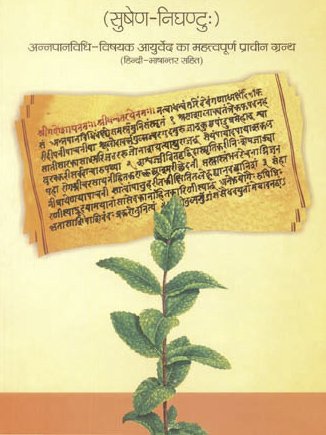Vishkira, Viṣkira: 12 definitions
Introduction:
Vishkira means something in Hinduism, Sanskrit. If you want to know the exact meaning, history, etymology or English translation of this term then check out the descriptions on this page. Add your comment or reference to a book if you want to contribute to this summary article.
The Sanskrit term Viṣkira can be transliterated into English as Viskira or Vishkira, using the IAST transliteration scheme (?).
In Hinduism
Ayurveda (science of life)
Veterinary Medicine (The study and treatment of Animals)
Source: Shodhganga: Portrayal of Animal Kingdom (Tiryaks) in Epics An Analytical studyViṣkira (विष्किर) (lit. “one who is a scatterer”) is a synonym (another name) for the Kukkuṭa, according to scientific texts such as the Mṛgapakṣiśāstra (Mriga-pakshi-shastra) or “the ancient Indian science of animals and birds” by Hamsadeva, containing the varieties and descriptions of the animals and birds seen in the Sanskrit Epics such as the Ramayana and Mahabharata.
Unclassified Ayurveda definitions
Source: Wisdom Library: Āyurveda and botanyViṣkira (विष्किर) is the Sanskrit name for a group of animals, referring to “birds who eat while scattering the grains”, the meat of which is used as a medicinal substance. Viṣkira is a sub-group of Māṃsavarga (“group of meat”). It is a technical term used throughout Āyurveda. They were originally composed by Caraka in his Carakasaṃhitā sūtrasthāna XXVII.
Animals in Viṣkira can be further classified in 2 sub-groups:
- Lāvādi (starting with the Lāva, or ‘common quail’),
- Vartakādi (starting with the Vartaka, or ‘male bustard’).
Birds such as the
- Lāva,
- Tittiri,
- Kapinjala,
- Vartira,
- Vartikā,
- Vartaka,
- Naptrikā,
- Vātika,
- Chakora,
- Kalavinka,
- Mayura,
- Krakara,
- Upachakra,
- Kukkuta,
- Sāranga,
- Shata-Patraka,
- Kutittiri,
- Kuruvāhuka
- and Yavalaka
belong to the Vishkira species. [They are so called from the fact of their picking up their food after scattering it first with their bills and claws (Skr. kira, to scatter)].
The flesh of a bird of this group is light, cooling, sweet and astringent in taste and tends to pacify the deranged humours of the body.
The Viṣkira is a sub-group of the Jāṅghala group (living in high ground and in a jungle).
Source: gurumukhi.ru: Ayurveda glossary of termsViṣkira (विष्किर):—Gallinaceous those animals and birds which disperse food before taking; Includes birds which scratch the earth in search of food. Exp the watail, wild fowl, snake bird, lapwing, peacock etc.

Āyurveda (आयुर्वेद, ayurveda) is a branch of Indian science dealing with medicine, herbalism, taxology, anatomy, surgery, alchemy and related topics. Traditional practice of Āyurveda in ancient India dates back to at least the first millenium BC. Literature is commonly written in Sanskrit using various poetic metres.
Languages of India and abroad
Sanskrit dictionary
Source: DDSA: The practical Sanskrit-English dictionaryViṣkira (विष्किर).—
1) Scattering about, tearing up.
2) A cock.
3) A bird, gallinaceous bird; छायापस्किरमाणविष्किरमुखव्या- कृष्टकीटत्वचः (chāyāpaskiramāṇaviṣkiramukhavyā- kṛṣṭakīṭatvacaḥ) Uttararāmacarita 2.9.
Derivable forms: viṣkiraḥ (विष्किरः).
Source: Cologne Digital Sanskrit Dictionaries: Shabda-Sagara Sanskrit-English DictionaryViṣkira (विष्किर).—m.
(-raḥ) 1. A bird in general. 2. Pulling or tearing to pieces. 3. A cock. E. vi before kṝ to scatter, and ka aff., with suṭ aug.
Source: Cologne Digital Sanskrit Dictionaries: Benfey Sanskrit-English DictionaryViṣkira (विष्किर).—i. e. vi-kṛ10 + a, m. 1. A bird, [Uttara Rāmacarita, 2. ed. Calc., 1862.] 40, 13. 2. Tearing to pieces.
Source: Cologne Digital Sanskrit Dictionaries: Cappeller Sanskrit-English DictionaryViṣkira (विष्किर).—[masculine] scratcher, a kind of bird.
Source: Cologne Digital Sanskrit Dictionaries: Monier-Williams Sanskrit-English Dictionary1) Viṣkira (विष्किर):—[=vi-ṣ-kira] m. (√kṝ) ‘scatterer’, a gallinaceous bird (such as a domestic fowl, partridge, quail etc.), [Gautama-dharma-śāstra; Yājñavalkya] etc.
2) [v.s. ...] a [particular] Agni, [Āpastamba-śrauta-sūtra]
3) [v.s. ...] any bird, [Horace H. Wilson]
4) [v.s. ...] pulling or tearing to pieces, [ib.]
Source: Cologne Digital Sanskrit Dictionaries: Yates Sanskrit-English DictionaryViṣkira (विष्किर):—(raḥ) 1. m. A bird in general; pulling to pieces.
[Sanskrit to German]
Sanskrit, also spelled संस्कृतम् (saṃskṛtam), is an ancient language of India commonly seen as the grandmother of the Indo-European language family (even English!). Closely allied with Prakrit and Pali, Sanskrit is more exhaustive in both grammar and terms and has the most extensive collection of literature in the world, greatly surpassing its sister-languages Greek and Latin.
Kannada-English dictionary
Source: Alar: Kannada-English corpusViṣkira (ವಿಷ್ಕಿರ):—[noun] a bird (in gen.).
Kannada is a Dravidian language (as opposed to the Indo-European language family) mainly spoken in the southwestern region of India.
See also (Relevant definitions)
Starts with: Vishkirarasa.
Ends with: Nakhavishkira, Smeravishkira.
Full-text (+23): Smeravishkira, Nakhavishkira, Upacakra, Vaishkira, Sharapada, Vishkirarasa, Vartika, Cakora, Kukkuta, Saranga, Vartaka, Krakara, Lava, Kapinjala, Naptrika, Vatika, Yavalaka, Kalavinka, Kutittiri, Vartira.
Relevant text
Search found 5 books and stories containing Vishkira, Viṣkira, Viskira, Vish-kira, Viṣ-kira; (plurals include: Vishkiras, Viṣkiras, Viskiras, kiras). You can also click to the full overview containing English textual excerpts. Below are direct links for the most relevant articles:
Sushruta Samhita, Volume 6: Uttara-tantra (by Kaviraj Kunja Lal Bhishagratna)
Chapter XLIX - Symptoms and Treatment of Vomiting (Chardi) < [Canto III - Kaya-chikitsa-tantra (internal medicine)]
Chapter LI - Symptoms and Treatment of Asthma (Shvasa) < [Canto III - Kaya-chikitsa-tantra (internal medicine)]
Chapter LXIV - Rules of Health < [Canto V - Tantra-bhusana-adhyaya (embellishing chapters)]
Sushruta Samhita, volume 4: Cikitsasthana (by Kaviraj Kunja Lal Bhishagratna)
Atharvaveda and Charaka Samhita (by Laxmi Maji)
2b. Tuberculosis (Yakṣmā or Rājayakṣmā) in the Caraka-Saṃhita < [Chapter 5 - Diseases and Remedies in Atharvaveda and Caraka-Saṃhitā]
Sushruta Samhita, volume 1: Sutrasthana (by Kaviraj Kunja Lal Bhishagratna)
Chapter XVI - Puncturing and Bandaging the ear
Chapter XLV - Knowledge of liquid substances
Sushruta Samhita, Volume 5: Kalpasthana (by Kaviraj Kunja Lal Bhishagratna)